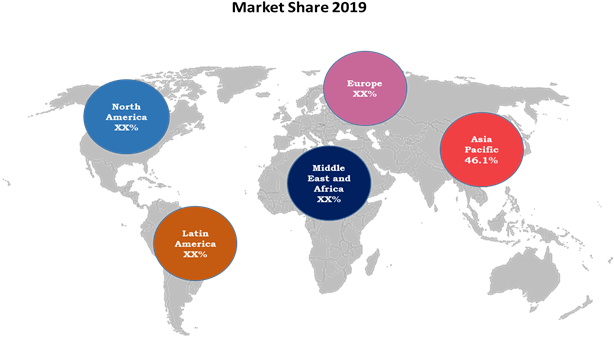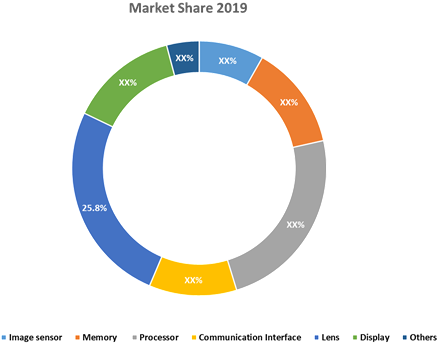
Market Overview
A smart camera or intelligent camera a term used for a connected camera that allows users to perform some additional functions including information extracting from captured image, information sharing, and real-time video analysis. A smart camera is a standalone, self-contained vision system with built-in actuators, pneumatic valves or relays. Smart cameras have numerous field applications including non-contact measurements, robot guidance, biometric recognition, part sorting and identification, code reading and verification, unattended surveillance, web inspection, detection of position and rotation of parts, etc. Smart cameras include different components including memory, image sensors, communication interface, lenses, processor, display, etc.
The global smart camera market is estimated to account for US$ 8,203.1 Mn in 2019 and is expected to grow at a CAGR of 23.3% % over the forecasted period 2019-27.
Market Dynamics- Drivers
The electronics and semiconductor industry across the globe is growing at a significant rate, owing to constant adoption of automation, networking, mobility, and smart project initiatives. According to the India Brand Equity Foundation (IBEF), the Indian semiconductor design market was valued at US$ 14.5 billion in 2015 and is expected to reach US$ 52.6 billion by 2020, exhibiting a CAGR of 29.4%. According to the same source, the Indian appliance and consumer electronics market was valued at US$ 10.93 billion in 2019 and is expected to reach US$ 21.18 billion by 2025. Thus, high growth of the semiconductor and electronics industry is expected to drive growth of the market during the forecast period.
Across the globe, food quality and safety regulations have become very strict. The food & beverage industry is bound to follow these regulations in order to maintain safety and quality of food products. For instance, MAF FRANCE, a French multinational designer and manufacturer of bagging, palletization and packing systems for fresh vegetables and fruit, has adopted GLOBAL SCAN, a sophisticated, fully automatic vision system, which allows packers to grade fruit accurately, as per the market requirement. Hence, these factors are expected to boost the market growth in the near future.
Key players in the market are focused on research and development activities, in order to innovate novel products. These players are constantly adding new features and technologies in their products, which in turn, is expected to drive the global smart camera market growth over the forecast period. For instance, in March 2015, Nikon Corporation introduced a DSLR camera ‘D7200’, which is equipped with the latest autofocusing system.
APAC region dominated the global smart camera market in 2019, accounting for 46.1% share in terms of value, followed by North America, Europe, North America, Latin America, and Middle East & Africa respectively.

To learn more about this report, Download Free Sample
Source: Coherent Market Insights
Market Dynamics- Restraints
Single chip smart camera is one of the lucrative concepts in smart camera systems. However, these camera systems are extremely expensive due to high manufacturing costs. Single chip smart cameras are also called as System on Chip smart cameras, in which all the component segments are integrated on a single chip. Being an innovative concept, single chip smart cameras are expensive, which is one of the major factors restraining their market growth. Thus, these factors are expected to hinder the market growth in the near future.
Smart cameras are targeted at the consumer segment have relatively limited software applications as compared to industrial smart cameras. Availability of a limited number of software applications is resulting in limited functions. Limited applications also restrict the use of smart cameras in different verticals. Many industrial smart camera players are focused on developing their own software for smart cameras though the consumer segment is still lagging in terms of software application development. Hence, these factors are expected to hamper the market growth in the near future.
Lack of standardization such as interchangeability of lenses from brand to brand, which is the major restricting factor in the global smart camera market. Companies provide smart camera component segments in varying forms, which results in component segment incompatibility between brands.
Market Opportunities
Consumers across the globe, especially in Western Europe are preferring smart homes as a result of policy enforcement by governments in this region. Man consumers are adopting smart appliances including smart cameras. Market players can capitalize on the untapped potential by offering novel products in the high potential regions.
Many countries across the globe, especially metropolitans in Asia Pacific are adopting smart camera-enabled intelligent transport systems. This is done to provide sophisticated transport services. For instance, in 2014, ComfortDelGro Corporation, a Singapore-based cab operator, announced trials for a new in-vehicle smart camera that is capable of alerting cabbies about potentially dangerous road situations.
Governments over various countries, especially Asia Pacific countries are investing significantly on smart city projects. For instance, in June 2015, the Government of India launched ‘100 Smart Cities Mission’, under which the government approved an investment of US$ 114 billion.

To learn more about this report, Download Free Sample
Source: Coherent Market Insights
Segment information:
In global smart camera market, by component segment, lens sub-segment dominated the global smart camera market in 2019, accounting for 25.8% share in terms of value, followed by processor, display, memory, communication Interface, image sensor and others respectively.

To learn more about this report, Download Free Sample
Source: Coherent Market Insights
Market Trends
Smart lenses have revolutionized digital camera photography. Smart lenses offer high-quality images and are equipped with power zoom and shoot-in-dark capabilities. As a result of this, the user gets an enhanced experience and improved images. For instance, Samsung offers a range of interchangeable NX smart lenses along with an NX smart camera for enhancing photography experience.
The use of smart cameras in industries such as healthcare, education, and entertainment is increasing, owing to improving global economic growth, increasing social acceptability and productive research interest. For instance, capsule endoscopy involves the use of micro smart camera-based devices to record images of digestive tracks. Moreover, consumer smart cameras facilitate online content sharing.
Competitive Section
Key companies operating in the global smart camera market are XIMEA GmbH, Fujifilm Corporation, Samsung Electronics Co., Ltd., Matrox Imaging, Canon Inc., Vision Components GmbH, Nikon Corporation, Microscan Systems, Inc., Sony Corporation, Hero Electronix Polaroid Corporation, Panasonic Corporation, and Olympus Corporation.
Key Developments
Share
Share
Missing comfort of reading report in your local language? Find your preferred language :
Transform your Strategy with Exclusive Trending Reports :
Frequently Asked Questions
Select a License Type
Joining thousands of companies around the world committed to making the Excellent Business Solutions.
View All Our Clients